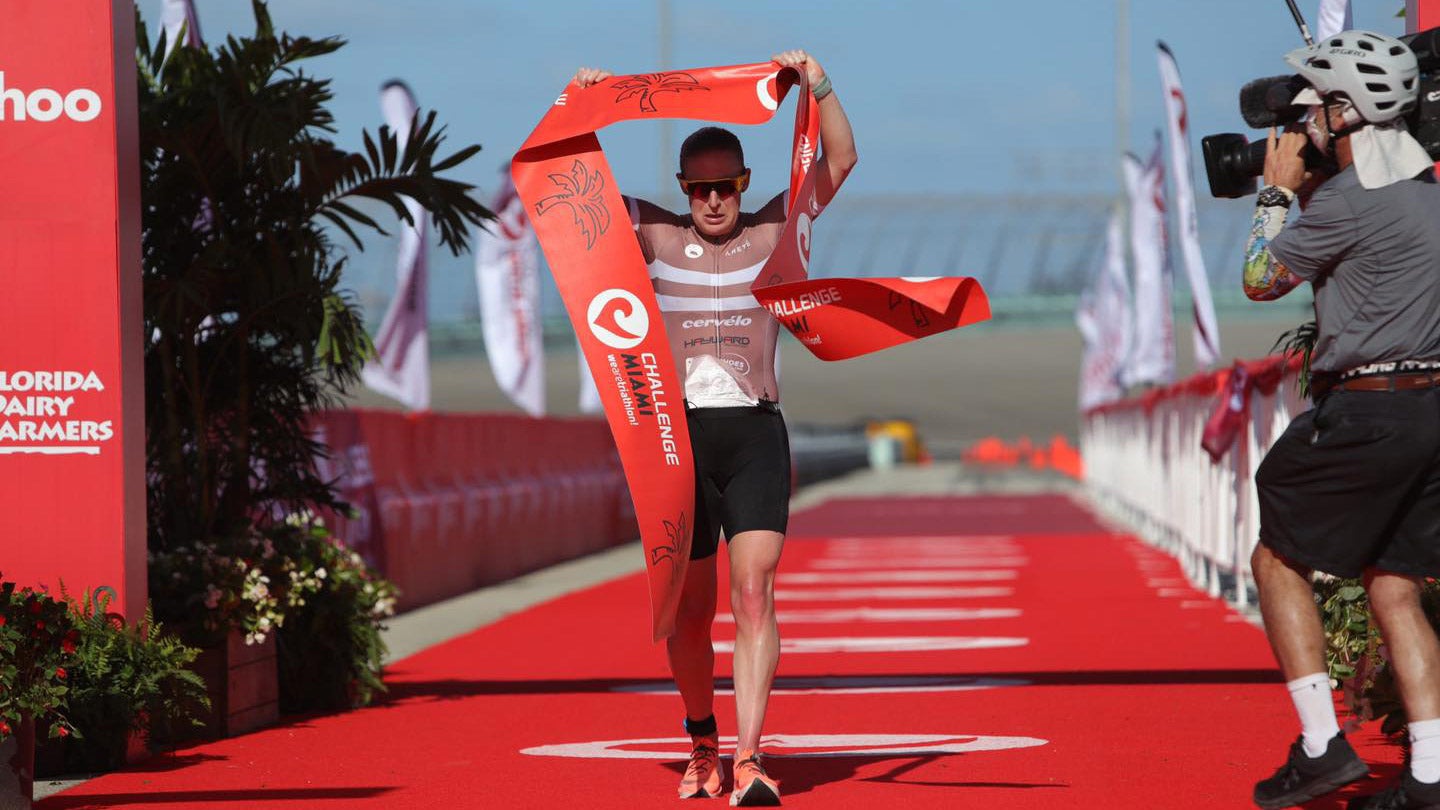8 Takeaways From The 2021 Challenge Miami Pro Women’s Race

(Photo: provided by Challenge Miami)
Last Friday marked a triumphant win for pro triathletes Jodie Stimpson and Jan Frodeno, as well as hope that 2021 will include a fairly-full race calendar. For many, 2020 was a year of learning how to adapt, overcome, and heal. Now as triathlons slowly start to return and we start to countdown those upcoming event dates on the calendar, it will be key to refresh key race skills that can make all the difference on your big day. From drafting behind the strongest swimmer to looking beyond the negatives, here are a few key takeaways from closely watching the 2021 Challenge Miami professional women’s race.
RELATED: Last Weekend Now: Jan and Jodie Win in Challenge Miami
Backstroke your way through sharp turns.
Being a strong swimmer isn’t the only skill needed to succeed in the swim leg of a triathlon. Lucy Charles-Barclay demonstrated outstanding technique in the swim course of Friday’s race. Formally a professional swimmer, Charles-Barclay’s ability to battle strong winds and choppy conditions certainly kept her ahead. However, it was her backstroke technique as she made her way around each buoy that blew her performance out of the water. Meanwhile for others, rounding the buoys was a costly setback causing athletes to fall behind or off course due to wide turns.
Save energy by drafting a strong swimmer.
Runner up out of the water Sara Pérez Sala also performed well in the swim. Rather than exhausting herself early on, Pérez Sala’s strategy involved drafting Charles-Barclay from start to finish. That’s not to say that keeping up with Charles-Barclay isn’t an amazing feat in and of itself. In doing so, Pérez Sala saved herself a substantial amount of energy, allowing the super swimmer to sweep the lead in T1. While she wasn’t first out of the water, the trade-off meant she came into T1 well-positioned and without using too much energy.
Consider clipping your bike shoes in before the race.
A continued debate among triathletes—to clip in or not to clip in. At Challenge Miami a handful of female pros clipped their bike shoes in prior to T1 versus putting them on first and then mounting the bike. While it can be challenging to do at first, it can certainly be done, and with practice comes perfection. At the end of the day, the moral of the story is obviously to do what works best for you. For podium winners Stimpson, Charles-Barclay, and Jackie Hering–the answer is to clip in prior. Note that some races have rules against clipping your shoes in prior to the event, so be sure to read regulations carefully.
Know the race rules.
A penalty for passing on one specific side vs. the other while on the bike is fairly rare (and usually less of an issue on a traditional course vs. a race track). But unfortunately for those racing in Challenge Miami, there was a two-minute penalty for not passing at three meters out and to the right. Even though it can be frustrating, we have to play by the rules. So, knowing the rules in advance and keeping them in mind on the course is always a winning strategy.
You can still finish strong even with a penalty.
While a penalty is not ideal, it certainly happens, even to the best in the sport. But that doesn’t mean you can’t make a comeback and finish out strong. Both Anne Haug (back at Challenge Daytona) and Charles-Barclay faced penalties in their recent speedway races and both athletes still made it to the podium. For the average triathlete, making up for lost time might not look the same as it does for the pros, but that doesn’t mean age-group athletes can’t make a comeback of their own.
If you do get a penalty, use your time in the tent wisely.
As Charles-Barclay made her way to the penalty tent before starting the run, you may have noticed how she grabbed all of her gear and made a run for the tent before putting any of it on. Even though she was stopped beforehand and asked to put on her shoes, the rest of her gear was all fair game. Every second counts in triathlon. Additionally, if you do get a penalty use the time in a tent to breathe and regroup. Freaking out about your penalty will do nothing but add to its impact on your overall outcome.
An athlete’s success is not measured by one performance.
They say no two race-day performances are the same and there’s a lot to be learned from that. Challenge Daytona female champion Paula Findlay is an excellent example of this. As she recently stated, Challenge Daytona was the “perfect day.” Factors such as course design, warmer temps, and headwinds can all impact an athlete’s performance. So, recognizing that not every race will be the same can actually be a useful tool in triathlon. Instead of letting yourself down about it, look at it as an opportunity to learn about your own strengths and weaknesses. After all, there’s always room for improvement.
We aren’t free of COVID-19 just yet.
Even though events are starting to happen, it’s important to remember that COVID-19 is still looming over us. Despite following the safety protocols, Ironman world champion Haug publicly announced that she tested positive the night before Challenge Miami. No matter how cautious we are as athletes, traveling to and competing in events comes with its risks.